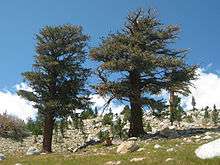Pinus balfouriana
| Foxtail pine | |
|---|---|
 | |
| Scientific classification | |
| Kingdom: | Plantae |
| Division: | Pinophyta |
| Class: | Pinopsida |
| Order: | Pinales |
| Family: | Pinaceae |
| Genus: | Pinus |
| Subgenus: | Strobus |
| Section: | Parrya |
| Subsection: | Balfourianae |
| Species: | P. balfouriana |
| Binomial name | |
| Pinus balfouriana Balf. | |
 | |
| Natural range of Pinus balfouriana | |
Pinus balfouriana (foxtail pine) is a rare high-elevation pine that is endemic to California, United States. It is closely related to the Great Basin and Rocky Mountain bristlecone pines, in the subsection Balfourianae. The two disjunct populations are found in the southern Klamath Mountains (subspecies balfouriana) and the southern Sierra Nevada[2] (subspecies austrina). A small outlying population was reported in southern Oregon, but was proven to have been misidentified.[3]
Description

P. balfouriana is a tree to 10–20 m (30–70 ft) tall, exceptionally 35 m (115 ft), with a trunk up to 2 m (7 ft) across. Its leaves are needle-like, in bundles of five (or sometimes four, in the southern Sierra) with a semi-persistent basal sheath, and 2–4 cm (1–1 1⁄2 in) long, deep glossy green on the outer face, and white on the inner faces; they persist for 10–15 years. The cones are 6–11 cm (2 1⁄2–4 1⁄2 in) long, dark purple ripening red-brown, with soft, flexible scales each with a 1-millimeter (1⁄16-inch) central prickle.
Distribution
P. balfouriana occurs in the subalpine forest at an elevation of 1,950–2,750 m (6,400–9,020 ft) in the Klamath Mountains, and at 2,300–3,500 m (7,500–11,500 ft) in the Sierra Nevada. In the Sierra Nevada, Foxtail pines are limited to the area around Sequoia and Kings Canyon National Parks. In both areas, it is often a tree line species.
Age
It is thought that P. balfouriana can live up to 3000 years in the Sierra Nevada, although the highest currently proven age is 2110 years. In the Klamath Mountains, ages are only known to about 1000 years.
Related species
P. balfouriana is closely related to the bristlecone pines, being classified in the same subsection Balfourianae; it has been hybridised with the Great Basin Bristlecone Pine in cultivation, though no hybrids have ever been found in the wild.
References
- ↑ Farjon, A. (2011). "Pinus balfouriana". IUCN Red List of Threatened Species. Version 3.1 (3.1). International Union for Conservation of Nature. Retrieved 2013-11-10.
- ↑ Moore, Gerry; Kershner, Bruce; Craig Tufts; Daniel Mathews; Gil Nelson; Spellenberg, Richard; Thieret, John W.; Terry Purinton; Block, Andrew (2008). National Wildlife Federation Field Guide to Trees of North America. New York: Sterling. p. 83. ISBN 1-4027-3875-7.
- ↑ Kauffmann, Michael E. (2012). Conifer Country. Kneeland, CA: Backcountry Press. ISBN 978-0-578-09416-8.OCLC 798852130.
Further reading
- Chase, J. Smeaton (1911). Cone-bearing Trees of the California Mountains. Chicago: A. C. McClurg & Co. p. 99. LCCN 11004975. OCLC 3477527. LCC QK495.C75 C4, with illustrations by Carl Eytel – Kurut, Gary F. (2009), "Carl Eytel: Southern California Desert Artist", California State Library Foundation, Bulletin No. 95, pp. 17-20 retrieved Nov. 13, 2011, Lanner, R.M. 2007 The Bristlecone Book, Ronald M Lanner, Mountain Press 2007 p. 14Conifer Specialist Group (1998). "Pinus balfouriana". IUCN Red List of Threatened Species. Version 2006. International Union for Conservation of Nature. Retrieved 11 May 2006.
- Bailey, D. K. 1970. Phytogeography and taxonomy of Pinus subsection Balfourianae. Ann. Missouri Bot. Gard. 57: 210–249.
- Mastrogiuseppe, R. J. & Mastrogiuseppe, J. D. 1980. A study of Pinus balfouriana Grev. & Balf. (Pinaceae). Systematic Botany 5: 86–104.
- Richardson, D. M. (ed.). 1998. Ecology and Biogeography of Pinus. Cambridge University Press, Cambridge. 530 p. ISBN 0-521-55176-5.
- Fryer, Janet L. (2004). "Pinus balfouriana". Fire Effects Information System (FEIS). U.S. Department of Agriculture (USDA), Forest Service (USFS), Rocky Mountain Research Station, Fire Sciences Laboratory – via https://www.fs.fed.us/database/feis/.
External links
| Wikimedia Commons has media related to: |
- Calflora: Pinus balfouriana CalFlora Database: Pinus balfouriana (foxtail pine)
- Gymnosperm Database — Pinus balfouriana
- USDA Plants Profile for Pinus balfouriana (foxtail pine)
- Arboretum de Villardebelle — photos of cones
- High Elevation White Pine Educational Website: Pinus balfouriana
- Conifercountry.com: Foxtail Pines in Northwest California
- Pinus balfouriana in the CalPhotos Photo Database, University of California, Berkeley

